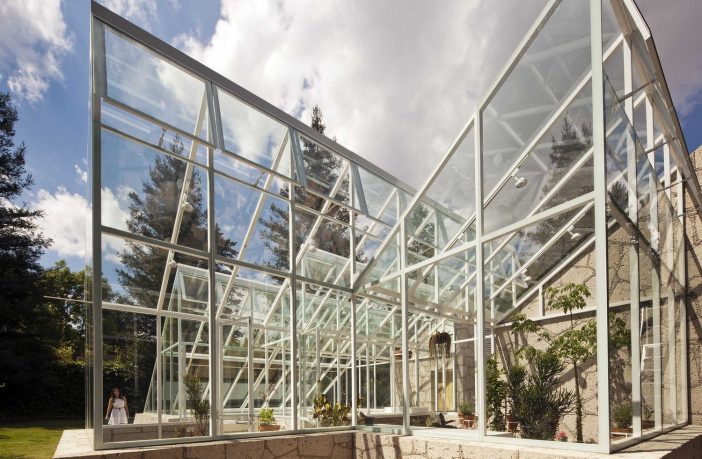Although the sun is almost 150 million kilometers away, this star has had the most impact on our planet. But while some are busy chasing the sun for sun-kissed skin, architects are all about creating sun-kissed spaces.
In definition, “passive solar energy is the collection and distribution of energy obtained by the sun using natural means”. The simple concept and process of implementing passive solar energy systems have provided buildings with heat, lighting, mechanical power, and electricity in the most environmentally-conscious way possible.
In this article, we will provide you with a complete guide of implementing passive solar systems in your designs.
The Sun
Passive solar energy is based on one element, the sun. Once the sun’s radiation hits Earth’s surface, the rays can either be absorbed, reflected, and/or transmitted. Transparent materials transmit the most sun radiation; however, translucent materials transmit just as much sun radiation, but will also scatter them as they pass through.
Not all materials absorb sun the same way. For instance, a polished/shiny surface will reflect radiation in larger amounts than matte surfaces. Similarly, dark surfaces absorb heat in larger amounts than light ones. Some surfaces will transmit radiation and store it at the same time, creating what we know as the “greenhouse effect.” This system stores the heat obtained by the sun, and preserves it for a long duration, as opposed to passive a “cooling system,” which absorbs the heat at a later stage.
What are passive systems?
Passive systems “collect and transport energy by non-mechanical, natural means”. Masonry (concrete, bricks, stones) and water (water wall, roof ponds) are the two most commonly used materials for radiation storage. The configuration behind passive systems consists of three types: direct gain, indirect gain, and isolated gain. Direct gain is when the project is heated and energized by direct sunlight reaching its surface (through a south-facing glass façade, for instance). Indirect gain is when the sunlight hits an alternate surface, absorbed, converted into thermal energy, and then transferred into the space (For instance, a masonry wall absorbs the sunlight and transports the heat absorbed into the interior space). “Attached greenhouses” are a combination of both direct and indirect gain systems, since they directly gain sunlight into the structure itself, yet also manage to transform this energy into the adjacent building, forcing an indirect gain. Isolated gain is a “natural collective loop” which involves the use of alternate material to absorb energy. These materials include a heat storage tank, a metal plate collector, water, air, and rock storage. A natural current takes place when the water collected by the container is heated by the sunlight, as it rises and enters the top of the storage tank.
Designing Passive Solar Energy
(The following design strategies are with respect to the Northern Hemisphere)
1- Location with respect to the sun: Optimum sun absorption is crucial for solar energy, which is why the project must be built in a way that takes full advantage of the sun during both summer and winter.
2- Structure’s design: The overall shape and orientation of a project can determine how much sun is being transferred into the space. It is observed that a building, which is elongated along the east-west axis, leads to additional absorption of sunlight on the south side during winter season.
3- Paying attention to the North-side: Since the sun does not directly emit radiation on the north side, architects can shorten its height, minimizing the amount of north-wall exposure. In addition, painting an adjacent wall with light colors can help reflect sunlight onto the northern wall.
4- Allocating interior rooms: Placing highly utilized rooms alongside the southeast, south, or southwest façades ensures maximum heating and lighting absorption. Rooms that require minimal heating/lighting such as corridors or utility rooms can be places alongside the northern side instead.
5- Window location: Placing large windows on the southern sides of the building ensures maximum sun emission into the interior space. Northern facades should have relatively smaller windows since they absorb the least thermal energy.
6- Sheltered entrance: To prevent cold air from entering the house whenever the door is opened during winter, orient the entrance door away from the wind’s direction and/or add a windshield next to the entrance.
7- Material selection: More energy is consumed if each material is used in its adequate place. Take a look at the table below to compare each material’s energy absorption percentages.

8- System Selection: Each project possesses specific design requirements, which is why different projects require different systems. There are often times when some passive energy systems are inappropriate, such as having large glass facades in a project that is surrounded by higher buildings, which in this case, the best solution would be to implement a system on the roof.
9- Glass facades / Solar Windows: South-facing glass facades and large windows absorb the most amount of solar radiation into the space. “Recommendation: In cold climates, provide between 0.19 and 0.38 sq ft. of south-facing glass for each one sq ft. of space floor area. In temperate climates, provide 0.11 to 0.25 sq ft of south facing glass for each one sq ft. of space floor area”.
10- Skylights: There are often times when having a glass façade is not feasible, which is why creating a skylight and/or clerestories, allow direct sunlight distribution into the space.
11- Masonry heat storage: Walls are recommended to be built with a minimum of 4-inch thickness to avoid indoor temperature fluctuations. A lightly colored interior, dark flooring, as well as small window patches on the wall allow for more sunlight diffusion in the space
12- Interior water wall: When using an interior water wall in the building, make sure the wall is located in a place that faces the sunlight in its peak time (11 am – 3 pm). Choose a dark-colored wall to optimize the sun absorption.
13. Thermal / Trombe Wall: Similar to the greenhouse principle, trombe walls are an external layer built adjacent to the “sunny side” of a building, which help preserve heat during the day and slowly release it overnight. These walls, which are often made of masonry and glass, provide warmth to the building through the glass layer and openings in the wall.
14- Wall dimensions: Properly sizing any type thermal wall will preserve as much heat as possible throughout the winter. “Recommendation: In cold climates, use between 0.43 and 1 sq ft. of south facing, double-glazed thermal storage wall for each one sq ft. of floor area (0.31 to 0.85 sq ft. of water wall dimensions). In temperate climates, use between 0.22 and 0.6 sq-ft. of thermal wall (0.16 – 0.43 sq ft. for water wall dimensions) for each one sq ft. of floor area.”*
Details: The wall thickness, material, and color/finishing, determine how effective the thermal wall is. To make the best of this trombe wall, choose a dark color on the side facing the sun, add vents at the top and bottom sides of the wall to increase its performance, and insert hinged panels over these vents to avoid reverse airflow.
15- Adjacent Greenhouse: Efficiently using the “adjacent greenhouse” concept can be a little complicated since the energy being transferred into the building is passing through a structure beforehand; therefore, the dimensions of the greenhouse must be calculated properly. “Recommendation: In cold climates, use between 0.65 and 1.5 sq ft. of south-facing double glass for each one sq ft. of building area. In temperate climates, use 0.33 – 0.9 sq ft. of glass for each one sq ft. of building area”.
16- Freestanding Greenhouse: Since greenhouses heavily depend on glass (or other translucent materials), sun will radiate into the entire space; however, the northern side of the greenhouse will receive less sun than the rest of the sides. It is preferable to elongate the east-west axis and paint the northern side with light colors to reflect sun into this area.
Details: To avoid interior temperature fluctuation in greenhouses, implement an interior water wall, use a rock storage system, and/or use solid masonry construction.
17- Roof pond: A roof pond’s area depends on the whether it is being used for heating or cooling systems, the materials it constitutes of, and the type of insulation being used. Here is a table to compare the rations of roof ponds depending on each pond’s characteristics.
Details: Roof ponds require extra attention to detail since they depend on the building’s structure and roof. The roof must be supported by waterproof metal or concrete deck, and left exposed to absorb as much heat as possible. The pond could be 6-12 inches deep, and made of waterproof dark-colored containers with transparent lids to allow sun rays to hit the water when concealed. As for the insulation panels, it is preferable if the panels are made as large as possible with reflective material, reducing the risk of water leakage and increasing the efficiency of the system.
18- Movable insulation: Glass and/or translucent material admit the most amount of sun into the space; yet, some of these radiations are lost at night due the same source that allowed them in. Covering the glass panels with movable insulation systems will decrease the amount of heat being released at night.
19- Reflectors: Sometimes, having large glass facades is not part of the proposed design, which is why adding reflectors enhances the amount of sun entering the space. “Recommendation: For vertical glazing, use a horizontal reflector roughly equal in width and one to two times the height of the glazed opening in length. For south sloping skylights, locate the reflectors above the skylight at a tilt angle of approximately 100 degrees, making the reflector’s dimensions equal to those of the skylight”.
20- Shading: Controlling the amount and trajectory of sun light entering the space is highly efficient and prevents it from entering rooms where sun gain is not required. “Recommendation: Shade the south glazing with a horizontal overhang allocated above the glazing. The shades should equal in length to roughly one-fourth of the opening’s height in Southern latitudes, and one half of the height in Northern latitudes”.
21- Outside Insulation: If the exterior walls are used as thermal walls, Place insulation panels on the exterior side to prevent any stored heat from being released.
Additional tips
Cloudy day storage: Cloudy locations require an increase in passive solar systems. Increasing the amount of south glazing, implementing a larger water wall (multiple ones if possible), as well as thickening the thermal walls (with respect to the standard recommendations mentioned above) will absorb higher amounts of sun into the space.
Summer cooling: The major emphasis on passive solar system is often the importance of allowing heat and light into the space during winter, disregarding the importance of cooling during the summer. Choosing a light-colored roof, ventilating the house at night, and closing the building during the day are some of the simple procedures that can be done to ensure summer cooling.
Tools: Several tools and applications are available that can help calculate the amount of sun entering the space. The cylindrical sun chart studies the altitude, azimuth, sky dome, sun’s position, sun’s path, monthly paths, latitude, and magnetic variations. Other tools such as the solar radiation calculator and shading masks can help determine all the necessary estimations before constructing the project.
Author: Dima Stouhi
Note: All the recommendations are obtained from The Passive Solar Energy Book by Edward Mazria
This article was first published in Arch Daily and is republished with permission.
Disclaimer: The articles expressed in this publication are those of the authors. They do not purport to reflect the opinions or views of Green Building Africa or our staff. The designations employed in this publication and the presentation of material therein do not imply the expression of any opinion whatsoever on the part Green Building Africa concerning the legal status of any country, area or territory or of its authorities.

























